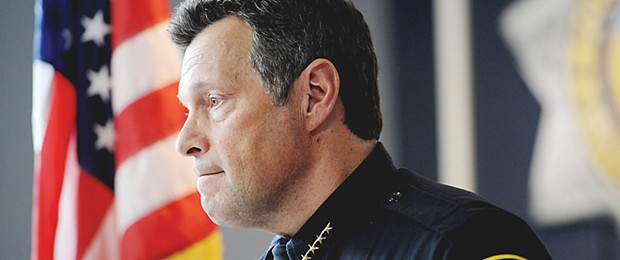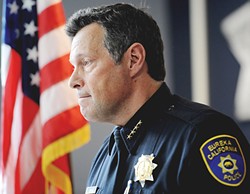Unanswered
Questions swirl in wake of EPD shooting
By Thadeus Greenson [email protected] @ThadeusGreenson[
{
"name": "Top Stories Video Pair",
"insertPoint": "7",
"component": "17087298",
"parentWrapperClass": "fdn-ads-inline-content-block",
"requiredCountToDisplay": "1"
}
]
It's been more than three weeks since police shot and killed 22-year-old Thomas "Tommy" McClain on the front lawn of his Eureka home and the questions keep coming: What was McClain doing with a very real looking BB gun? Why would he reach for it when being held at gunpoint by the cops? Could police have done something differently? Did they have to kill him?
Eureka Police Chief Andy Mills gave the public its first real glimpse of what happened that night during an Oct. 1 press conference. Over the course of about 30 minutes, Mills walked local reporters through the facts turned up by an ongoing EPD-led, multi-agency investigation. For a detailed rundown of Mills' press conference, visit www.northcoastjournal.com., but the basics are that on Sept. 17, police were in the area of the Allard Avenue duplex McClain shared with his cousin, his cousin's wife and their kids, searching for a wanted fugitive who was believed to be armed and dangerous and staying in the duplex neighboring McClain's. Two officers were keeping watch from the cemetery across the street, officer Stephen Linfoot was circling the neighborhood in his black and white marked patrol car and Sgt. Brian Stephens was stationed nearby, coordinating the effort.
Officers say they saw McClain angrily confront a man in front of his house, accusing him of selling drugs in the neighborhood. The cops suspected McClain might have a gun, so Stephens instructed Linfoot to drive by, hoping a visible police presence would make McClain retreat back inside. Instead, after Linfoot's patrol car passed, officers say they saw McClain pull a gun from his waistband and cycle it, an action that pulls a bullet into the chamber and renders a semi-automatic pistol ready to fire. Stephens, fearing an imminent armed exchange between McClain and the other man, then decided to confront McClain. He pulled up in his patrol car, illuminated McClain with his vehicle's spotlight and held him at gunpoint. Meanwhile, Linfoot converged on the scene and set up to McClain's right, also pulling his handgun and keeping it trained on the suspect. Initially compliant, police say McClain raised his hands, which pulled his shirt up and left the gun on his waistband clearly visible. According to Mills, Stephens said, "I see the gun. Don't touch it or I will shoot." McClain then lowered his hands, ultimately bringing one down to the gun. Seeing this, Linfoot opened fire. Stephens also readied to fire, Mills said, but McClain was falling to the ground by the time he was in Stephens' sights and the sergeant had his finger on the trigger.
The entire interaction lasted about a minute, Mills said, with the shooting itself over in two seconds. There's no video footage of the complete incident, and police say no civilian witnesses saw it in its entirety.
A pair of qualified expert witnesses on police use of force interviewed by the Journal offered differing views on the shooting. Richard Lichten, a former lieutenant with the Los Angeles County Sheriff's Department, declined to comment specifically on McClain's case, but briefed on the basic underlying facts said it sounds like officers acted appropriately.
"It's irrelevant that (the gun) turns out to be fake," Lichten said. "It looks real. The objective evidence is that the man is reaching for a weapon. ... What do you expect an officer to do?"
That's fair, said Robert Feliciano, a former training sergeant with the Los Angeles County Sheriff's Department, but doesn't really get to the heart of the matter.
"It's a bad shooting, period," Feliciano said. "But is it a justifiable shooting? The answer is probably yes. ... But the word is causation. What caused the incident?"
During his press conference, Mills said the community is now dissecting — in the light of day and the comfort of homes and offices — the decisions officers made in seconds that night. But Feliciano said it didn't really have to be that way. Maybe they could have taken a wait-and-see approach? When they decided to approach him, maybe Stephens — a former SWAT officer — could have come up with a more tactical plan. "We have more time than that," Feliciano said. "Take cover. Use your verbal commands. ... They created this incident. I'm not saying it was with malice, but (the police) saw something, they took action and what they thought they saw isn't really what they saw. They saw a kid with a BB gun, and a kid with a BB gun who broke no laws is now dead."
Lichten disagreed, saying that, given the circumstances, officers understandably felt they needed to intervene to prevent a potentially violent interaction. And, after all, Lichten added, "If the guy would have done what he was told and laid down, we wouldn't be having this conversation."
So why didn't Tommy McClain lie down? Who would reach for an unloaded BB gun in the face of real weapons and men trained to use them? Why'd McClain even have the BB gun in the first place?
Feliciano said the situation doesn't make any sense. There's the well-established phenomenon known as "suicide by cop," where a desperate individual forces an interaction with police, but McClain doesn't fit that paradigm, with his Facebooking moments before the shooting, his chance encounter with police and no indications of depression or a life in crisis.
Given the facts available, it's possible McClain — whose boss described him as a good, hardworking employee of a local roofing company — was frustrated that he and his nieces were living next to a property Mills described as a "flop house," a place where dangerous people were known to frequent and that was well on the radar of Eureka's Problem Oriented Policing Team. Maybe he picked up a real-looking BB gun hoping it would scare off thugs and drug dealers and buy his family a little space. Maybe it helped embolden him to confront people he felt were doing unsavory things in his neighborhood. Or, maybe he was just a 22-year-old prone to bad choices?
But neither of those explain why he'd reach for the gun in front of police. McClain had a hearing disability and had reportedly been out drinking prior to the shooting. Is it possible he misunderstood officer's orders? The Journal attempted to reach out to Mills the day after the press conference to clarify if any officer other than Stephens was issuing commands and if anyone on scene may have told McClain to "drop the gun," but Mills declined to comment, saying the department wouldn't be commenting further until the investigation reveals additional information.
During the press conference, Mills said an autopsy revealed that one of Linfoot's shots hit McClain in the outer arm, piercing his bicep, passing through and hitting him in the chest. This, Mills said, "demonstrates that the arm could not have been in the air" when McClain was shot. But, that's far from conclusive evidence that McClain was reaching for the gun as there's no telling which of Linfoot's seven bullets caused that damage. Humboldt County Deputy Coroner Roy Horton said a forensic pathologist has yet to determine a sequence of shots in the case, meaning it's possible McClain had already been shot — or was reacting to one of Linfoot's errant shots — when the bullet struck his arm.
One thing both experts agree on is that once an officer makes the decision to fire his weapon, the intent is and has to be to stop the threat. "We don't train to wing somebody," said Feliciano. "It's not like the movies where you shoot the gun out of his hand and crap like that. Body mass is where we shoot, and you shoot body mass and there's going to be critical wounds."
Feliciano said a frustrating part of officer-involved shooting fatalities is that they rarely leave behind a full story, as the suspect is deceased and cops — with incredibly high stakes — are taught culturally and systemically not to admit their mistakes. "Sometimes you make a bad decision, but you can't admit it or even admit that you regret it," he said. "We're all humans and humans make mistakes. But if you make a mistake at 1,100 or 1,200 feet per second and the mistake is seven times compounded, you'll never really know what happened that day other than that you have a 22-year-old kid dead and we only have part of the story."
Comments (5)
Showing 1-5 of 5
more from the author
-
Deputy Shoots Cutten Shooting Suspect
- Apr 25, 2024
-
Officials Weigh in on SCOTUS Case's Local Implications
- Apr 25, 2024
-
Arcata Lowers Earth Flag as Initiative Proponents Promise Appeal
- Apr 25, 2024
- More »
Latest in News
Readers also liked…
-
Through Mark Larson's Lens
A local photographer's favorite images of 2022 in Humboldt
- Jan 5, 2023
-
'To Celebrate Our Sovereignty'
Yurok Tribe to host gathering honoring 'ultimate river warrior' on the anniversary of the U.S. Supreme Court ruling that changed everything
- Jun 8, 2023



































